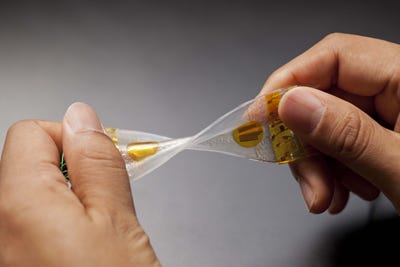What Are Wearables Good For? This Research Partnership Wants to Find Out
May 28, 2015
University of Rochester researchers plan to put MC10's flexible electronics sensors to the test in a variety of clinical settings.
|
MC10 has technology for flexible, stretchable electronics. (Photo courtesy of MC10) |
Chris Newmarker
Flexible electronics pioneer MC10 on Thursday announced a research partnership with the University of Rochester to achieve advances in predictive health analytics using MC10's wearable health sensor technology.
A diverse array of Rochester researchers will take advantage of MC10's BioStamp platform. The BioStamp includes a sensing sticker that flexes, stretches and moves with the body, as well as a companion software application and an end-to-end cloud storage and computing platform.
Comfort and flexibility are major advantages for the BioStamp, MC10 CEO Scott Pomerantz tells Qmed. "You get clinical fidelity outside of the clinic, the research environment, the physician's office. ... You can wear it multiple places on the body precisely at the same time."
MC10 (Cambridge, MA) is even opening an office in Rochester, NY, to support the work.
The idea is to combine MC10's capabilities in physiological sensing and pattern recognition algorithms with the University of Rochester's clinical expertise and commitment to big data analytics.
The University of Rochester has even committed $100 million to the creation of the Georgen Institute for Data Science, a center that will focus on using healthcare data and analytics to advance medicine.
"We see great potential in working with MC10 and in exploiting the biometric insights that are realized from MC10's technology platform in addressing some of the greatest challenges we see in healthcare today," Robert Clark, dean of the University of Rochester's School of the Hajim School of Engineering and Applied Sciences, said in a news release.
University of Rochester neurology professor Ray Dorsey, MD, plans to use MC10's BioStamp to better study neurodegenerative disease.
"Wearable sensors, like those from MC10, can enable objective, sensitive, frequent assessments of an individual's condition to improve their health and advance new treatments for neurological conditions," Dorsey said in a news release. "Through the seamless exchange of data between patients and physicians we can move healthcare outside of the clinic and truly overcome distance and disability."
The University of Rochester news is but the latest example of MC10's quest to determine the BioStamp's potential. Last year, MC10 announced a partnerhips with global biopharmaceutical company UCB to develop symptom-tracking devices for patients with movement-tracking disorders.
"Motion-based neurological diseases is a key area," Pomerantz said. He said expect more positive news from MC10 in the near future.
The BioStamp's silicon circuits are a fraction of the width of a human hair. Along with elastic rubberlike polymers, they form complete powered systems that sense, measure, analyze, and communicate information including data from the brain, muscles, heart, body temperature, and body movement. Thin film battery technology can be recharged wirelessly.
The BioStamp, though, is only a measurement tool. The next step is to figure out the usefulness of the data it is able to collect.
Refresh your medical device industry knowledge at MD&M East in New York City, June 9-11, 2015. |
Chris Newmarker is senior editor of Qmed and MPMN. Follow him on Twitter at @newmarker.
Like what you're reading? Subscribe to our daily e-newsletter.
About the Author(s)
You May Also Like



